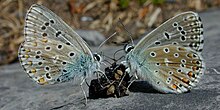
Back آكلات الحتات Arabic Detritívor Catalan پاشماوەخۆر CKB Nedbrydere Danish Rubomanĝanto Esperanto Detritívoro Spanish Detritofaag Estonian Detritiboro Basque پودهخوار Persian Détritivore French

Detritivores (also known as detrivores, detritophages, detritus feeders or detritus eaters) are heterotrophs that obtain nutrients by consuming detritus (decomposing plant and animal parts as well as feces).[1] There are many kinds of invertebrates, vertebrates, and plants that carry out coprophagy. By doing so, all these detritivores contribute to decomposition and the nutrient cycles. Detritivores should be distinguished from other decomposers, such as many species of bacteria, fungi and protists, which are unable to ingest discrete lumps of matter. Instead, these other decomposers live by absorbing and metabolizing on a molecular scale (saprotrophic nutrition). The terms detritivore and decomposer are often used interchangeably, but they describe different organisms. Detritivores are usually arthropods and help in the process of remineralization. Detritivores perform the first stage of remineralization, by fragmenting the dead plant matter, allowing decomposers to perform the second stage of remineralization.[2]
Plant tissues are made up of resilient molecules (e.g. cellulose, lignin, xylan) that decay at a much lower rate than other organic molecules. The activity of detritivores is the reason why there is not an accumulation of plant litter in nature.[2][3]

Detritivores are an important aspect of many ecosystems. They can live on any type of soil with an organic component, including marine ecosystems, where they are termed interchangeably with bottom feeders.
Typical detritivorous animals include millipedes, springtails, woodlice, dung flies, slugs, many terrestrial worms, sea stars, sea cucumbers, fiddler crabs, and some sedentary marine Polychaetes such as worms of the family Terebellidae.
Detritivores can be classified into more specific groups based on their size and biomes. Macrodetritivores are larger organisms such as millipedes, springtails, and woodlouse, while microdetritivores are smaller organisms such as bacteria.[4][5]
Scavengers are not typically thought to be detritivores, as they generally eat large quantities of organic matter, but both detritivores and scavengers are the same type of cases of consumer-resource systems.[6] The consumption of wood, whether alive or dead, is known as xylophagy. The activity of animals feeding only on dead wood is called sapro-xylophagy and those animals, sapro-xylophagous.
- ^ Wetzel RG (2001). Limnology: Lake and River Ecosystems (3rd. ed.). Academic Press. p. 700. ISBN 978-0-12-744760-5.
- ^ a b Keddy P (2017). Plant Ecology, Origins, Processes, Consequences 2nd Ed. New York: Cambridge University Press. pp. 92–93. ISBN 978-1-107-11423-4.
- ^ Sagi N, Grünzweig JM, Hawlena D (November 2019). "Burrowing detritivores regulate nutrient cycling in a desert ecosystem". Proceedings. Biological Sciences. 286 (1914): 20191647. doi:10.1098/rspb.2019.1647. PMC 6842856. PMID 31662076.
- ^ Schmitz, Oswald J; Buchkowski, Robert W; Burghardt, Karin T; Donihue, Colin M. (2015-01-01), Pawar, Samraat; Woodward, Guy; Dell, Anthony I (eds.), "Chapter Ten – Functional Traits and Trait-Mediated Interactions: Connecting Community-Level Interactions with Ecosystem Functioning", Advances in Ecological Research, Trait-Based Ecology – From Structure to Function, vol. 52, Academic Press, pp. 319–343, doi:10.1016/bs.aecr.2015.01.003, archived from the original on 2021-05-30, retrieved 2021-02-20
- ^ De Smedt, Pallieter; Wasof, Safaa; Van de Weghe, Tom; Hermy, Martin; Bonte, Dries; Verheyen, Kris (2018-10-01). "Macro-detritivore identity and biomass along with moisture availability control forest leaf litter breakdown in a field experiment". Applied Soil Ecology. 131: 47–54. Bibcode:2018AppSE.131...47D. doi:10.1016/j.apsoil.2018.07.010. ISSN 0929-1393. S2CID 92379245.
- ^ Getz WM (February 2011). "Biomass transformation webs provide a unified approach to consumer-resource modelling". Ecology Letters. 14 (2): 113–24. Bibcode:2011EcolL..14..113G. doi:10.1111/j.1461-0248.2010.01566.x. PMC 3032891. PMID 21199247.